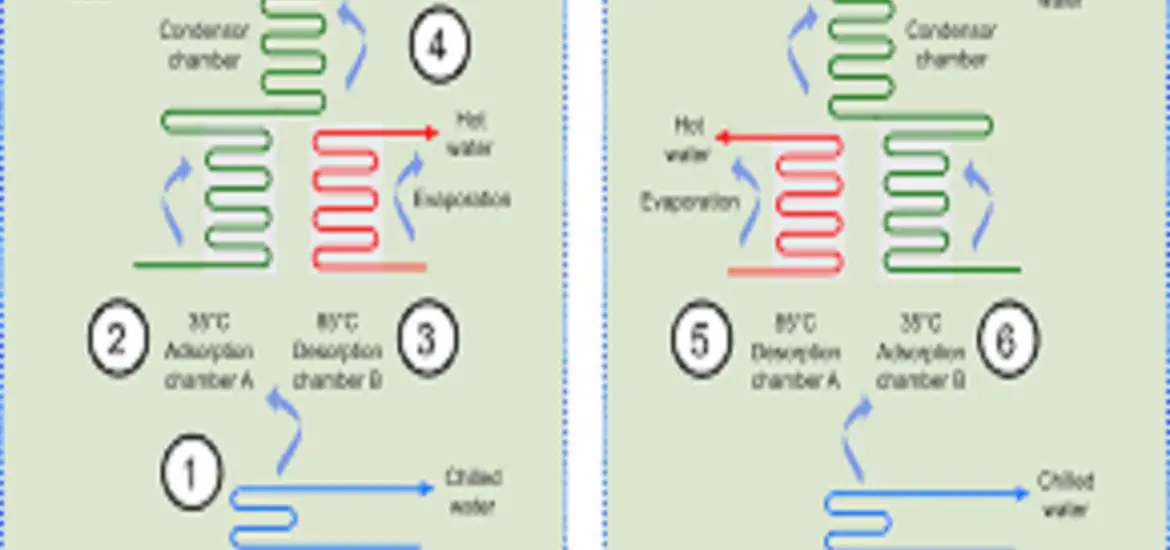Absorption chiller efficiency is a hot topic when it comes to finding eco-friendly and cost-effective cooling solutions. In this article, we’ll explore the ins and outs of absorption chillers, comparing them to other cooling systems, and discovering the factors that impact their performance. So, let’s jump right in and start understanding this amazing technology!

Table of Contents
Introduction to Absorption Chillers
Principle of Absorption Chillers
Did you know that absorption chillers use heat instead of electricity to cool spaces? It may sound like magic, but it’s actually based on some cool science! These chillers leverage the absorption and evaporation processes, where a refrigerant is absorbed by an absorbent, and then evaporated to produce cooling. How do they stack up against traditional cooling systems? Well, they’re generally more energy-efficient and environmentally friendly, making them an attractive option for a greener world.
Advantages and Disadvantages
Like any technology, absorption chillers come with their own set of pros and cons. On the bright side, they’re energy-efficient, eco-friendly, and produce less noise than conventional systems. But on the flip side, they have higher initial costs and are typically bulkier. Is it worth it? That depends on your priorities and the specific application!
Read more about absorption here – – Absorption Refrigeration: Easy Guide to Understanding It
Absorption Chiller Efficiency Factors
Types of Absorption Chillers
Did you know there are different types of absorption chillers? You’ve got single-effect, double-effect, and even triple-effect chillers! The main difference between them is the number of stages involved in the cooling process. The more stages, the higher the efficiency – but also the higher the cost. It’s important to weigh the benefits and drawbacks to find the perfect fit for your needs.
Heat Source
The type of heat source used in an absorption chiller can greatly impact its efficiency. Options include natural gas, solar energy, and even waste heat from industrial processes. By choosing the right heat source for your application, you can optimize the performance of your chiller and make it even more eco-friendly!
Refrigerant and Absorbent Pairs
What makes absorption chillers tick? It’s all about the refrigerant and absorbent pair! Common pairs include water and lithium bromide, or ammonia and water. The choice of refrigerant and absorbent affects efficiency, as well as other factors like safety and environmental impact. It’s essential to select the best combo for your specific situation.
Cooling Load
Managing the cooling load is key to maintaining absorption chiller efficiency. By implementing strategies like load shifting or using multiple chillers, you can ensure that your system runs optimally and saves you money in the long run. Who wouldn’t want that?
Absorption Chiller Temperature Range
Influence of Temperature on Efficiency
Temperature plays a critical role in absorption chiller efficiency. Did you know that these chillers have an optimal temperature range in which they work best? Operating outside this range can lead to reduced efficiency and even system failure. It’s crucial to keep things running smoothly by maintaining the right temperature!
Temperature Control Strategies
How can you ensure your absorption chiller stays within its optimal temperature range? There are several techniques, like using heat exchangers, adjusting the cooling load, or integrating with building management systems. By employing these strategies, you’ll not only keep your chiller running at peak efficiency but also extend its lifespan and reduce maintenance costs. Sounds like a win-win, right?
Absorption Cooling Efficiency
Coefficient of Performance (COP)
When it comes to measuring absorption cooling efficiency, the Coefficient of Performance (COP) is the go-to metric. What is COP, you ask? It’s the ratio of cooling output to the heat input. Factors like the type of chiller, heat source, and refrigerant-absorbent pair can all influence the COP. How do absorption chillers compare to other cooling systems? Generally, they have a lower COP than conventional systems, but their eco-friendly nature and lower operating costs often make up for it.
Improving Absorption Cooling Efficiency
Looking to get the most out of your absorption chiller? There are several ways to improve its efficiency, from retrofitting existing systems to incorporating advanced technologies. Regular maintenance and following best practices for operation also play a significant role in maximizing efficiency. After all, who doesn’t love getting more bang for their buck?
Real-world Applications and Case Studies
Absorption chillers have been successfully installed in various industries, showcasing their energy-saving potential and efficiency improvements. From large commercial buildings to industrial facilities, these chillers prove time and time again that they’re a viable alternative to traditional cooling systems. By learning from these real-world examples, we can better understand the potential of absorption chillers and their impact on our environment.
Conclusion
In conclusion, absorption chiller efficiency is a critical aspect of this eco-friendly cooling technology. By understanding the various factors that influence efficiency, selecting the right equipment, and employing best practices, we can make the most of these innovative systems. As we strive for a greener and more sustainable future, absorption chillers will undoubtedly play a vital role in our journey towards energy efficiency and reduced environmental impact.